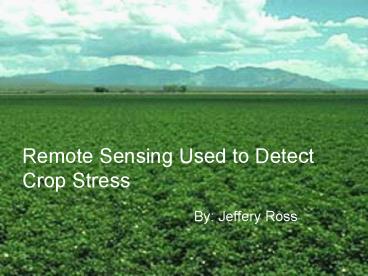Remote Sensing Used to Detect Crop Stress - PowerPoint PPT Presentation
1 / 21
Title:
Remote Sensing Used to Detect Crop Stress
Description:
These use CCD-cameras and/or video. Mounted under the plane to capture light reflectance. ... The blimp is fitted with two off-the-shelf cameras. ... – PowerPoint PPT presentation
Number of Views:900
Avg rating:3.0/5.0
Title: Remote Sensing Used to Detect Crop Stress
1
Remote Sensing Used to Detect Crop Stress
By Jeffery Ross
2
Why is This Important?
- This new technology could benefit farmers
through-out the world. - By using remote sensing to detect crop stress,
mainly water stress, the farmer would know when
to irrigate. - This technology would create a more efficient
watering schedule - This would increase his/her crop yields
3
What is Remote Sensing?
- Process of gathering image-based information from
a remote target, in much of the same way we use
cameras to capture information. - There are two main types
- Passive
- Active
4
Contd
- Passive detects reflected and transmitted energy.
- This energy generally originates from the sun.
- Passive sensors that require sunlight are only
operational during the middle of the day to
reduce shadowing. - Clouds and moisture can be a problem
5
Active Sensors
- Active sensors emit and then detect the
reflection of this energy from a ground target. - These sensors can penetrate clouds and work
during the day and night
6
How are these useful in Ag
- They can provide information about plant growth,
stress presence and moisture. - Which in turn can determine nitrogen content,
identify diseases and irrigation scheduling.
7
What platforms are currently being used in Ag
- Satellites
- Air-borne
- Hand-Held
8
Satellites
- Operate 700 km from Earth
- Large areas can be imaged quickly
- Ouick-Bird and IKONOS
9
Air-borne
- These use CCD-cameras and/or video
- Mounted under the plane to capture light
reflectance. - Images are taken in series and can be stitched
together to create a full scene.
10
Hand-Held
- These are mounted near the target (crops)
- Mounted on tractors, Sprayers ect.
- Basically using a camera.
- Captures light from the canopy.
11
The Process
- When farmers observe their fields to assess their
condition without physically touching them, its
a form of remote sensing. - Remotely sensed images taken from satellites and
aircraft provide mean to assess them without
touching. - Most remote sensors see the same visible
wave-lengths of light that we see.
12
Contd
- But in most cases remote sensors detect energy
from wave lengths that are undetectable by the
human eye. - The ability to store, analyze and display the
data on field maps is what makes remote sensing a
potentially important tool for farmers.
13
Contd
- Basic principles of remote sensing with
satellites and aircraft are similar to visual
observations. - Energy in the form of light waves travels from
the sun to the earth. - These waves travel similar to waves across a
lake, the distance from peak to peak is the
wave-length. - Most applications in Ag cover the electromagnetic
spectrum.
14
Contd
- The EM energy strikes the plants and three things
happen. - The energy will be reflected, absorbed, or
transmitted. - Reflected energy bounces off leaves and is
identified as green. - The leaves absorbs much of the energy and the
green color id reflected.
15
Contd
- Sunlight that is not absorbed or reflected
through the leaves goes to the ground. - Interactions between reflected, absorbed, and
transmitted can be detected by remote sensing. - Remote sensing is used to determine signatures in
the field and then can be used to detect stress
areas. - First est. healthy plants to find the altered
ones.
16
(No Transcript)
17
(No Transcript)
18
Techniques in use now
- Glen Ritchie and Craig Bednarz are two
researchers at UGA. - They developed a blimp to help fine tune
irrigation. - The blimp is fitted with two off-the-shelf
cameras. One takes a regular image the other is
fitted with a near-infrared filter. - Cover 5 acres in about 10 minutes.
19
(No Transcript)
20
My proposed plan
- Combine hyper-spectral images, number of sensors
through-out the field and a variable rate
irrigation system. - The images would represent stressed plants and
where, the sensors in the field would measure
soil moisture, then the VRI would come hand in
hand. - The images could be downloaded to a lab-top.
- A monitor mounted on the pivot that could
interpret the data from the sensors.
21
(No Transcript)































